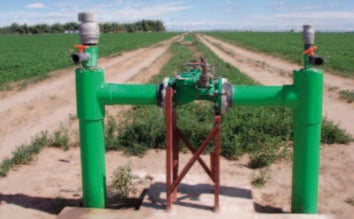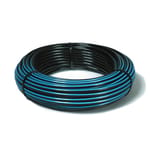Crop Solutions: Drip Irrigation On Alfalfa
Bob Thomas Farms, Seeley, CA, USA
Project Details
- Location
- Bob Thomas Farms, Seeley, CA, USA
- Project Year
- 2009
- Size
- 116 Acres Of Farmland
Benefits Of Drip On Alfalfa:
- Increased yields & water use efficiency
- Reduced harvesting costs, labor cost, energy use & weed growth
Bob Thomas is a newcomer to farming, but no stranger to success. With the proceeds of his recently sold construction company, he has purchased ranches in Utah, Colorado and California’s Imperial Valley. In California on the Lyons Road Ranch near Seeley, he plans to continue growing the same crops that have been grown for decades, but not the same way. Rather than gravity irrigating the alfalfa with traditional flood irrigation with borders, Thomas and his son Rob have installed a subsurface drip irrigation system on 116 acres of the 660 acre ranch. And they already have plans to install another 250 acres this summer. “When I learned how water was applied to crops here, I began researching alternatives. In the process, I discovered how a few cutting edge growers were using drip to not only save water, but significantly increase yields as well. That’s what I’m after – getting more crop per drop – and making this farm as efficient as my construction company was.”
Getting More Crop Per Drop
After months of research, the Thomas’ settled on a design and ordered materials. Towards the end of August 2009, they installed Toro’s 7/8” Aqua-Traxx drip tape with a 10mil wall thickness and 12 inch emitter spacing. The tape lines were injected 10-12 inches deep with 40 inch lateral spacing to accommodate both alfalfa and future vegetable crops as well. “The system is designed to apply about .06 inches of water per hour, and peak ET can be replaced on the whole system in about 16 hours of any 24 hour day. This way we have a little breathing room if we need to run a little longer or work around harvest logistics.” The Thomas’ planted the drip blocks in September, and by May have already cut three times to reap a total of 4.5 tons of alfalfa per acre. Since they are irrigating the rest of the ranch’s alfalfa acreage with traditional flood irrigation with borders, they have a basis for comparing one method to the other. “Harvesting the drip field was a lot easier than harvesting the bordered fields,” says Thomas. “With flood irrigation with borders, it’s a two step operation to accommodate all the different elevations, but with drip, the field is planted f lat with no waste, so harvesting was as easy as mowing the lawn.”
"Other growers have achieved 30 - 40% more yield - there is no reason why we can't."
Just ten days after harvest there is already healthy re-growth. “We are hoping to achieve annual yields of 16-17 tons per acre with this system – that’s how we will recover the investment. As we work out the installation and construction bugs, future investment costs will be lower, but bottom line, with water at $18 per acre foot today, it’s the yield that is motivating us.” The flood irrigated fields typically use about one acre foot of water per ton of yield. On average, that equates to about 12-13 acre feet of water per acre to yield about 12-13 tons of alfalfa per acre. “Even if we use the same amount of water in the future, which I doubt we will, we will hopefully be yielding 30 to 40 percent more alfalfa with the same amount of water. Other growers have achieved this – there is no reason why we can’t.”
The system was built for longevity and efficiency. Buried PVC pipelines feed the tape laterals at the top end of the field, and collect water from the ends of the lines to allow f lushing via gate valves every 2 weeks or so. Specialized valves regulate the pressure to each block and ensure that air is released and vacuum prevented at system start-up and shut down. Filters cleanse the water of organic and inorganic contaminants, including weed seeds, from the canal water, and a chemigation unit injects fertilizer and acid to control pH.
Two variable frequency drive lift pumps pressurize the water f lowing from the Imperial Irrigation District’s Westside Canal directly into the drip system. The pumps run at optimum efficiency during both irrigation and flushing and will significantly reduce energy costs compared to the existing flood irrigation pumps. “The old pumps run at about 50% efficiency, while the new pumps run at over 90% efficiency at all times.” Irrigation scheduling is probably one of the most challenging tasks. Drip systems irrigate at the push of a button and don’t require field preparation or a lot of labor, so growers have the luxury to decide exactly when to irrigate and for how long. In addition, varying soil textures, harvest schedules, weather conditions and district water availability add to the complexity. But the Thomas’ are tackling the logistics and getting the hang of it in hopes of improving efficiency and increasing yields. “Most of the ranch is a sandy loam, but there are areas that are even lighter and need water more often. With flood irrigation, with borders, extra water was always diverted to these areas haphazardly. With drip, we will run those blocks a little more often to more precisely satisfy crop needs,” says Rob Thomas.
Labor and dry down times are also affected by the drip system. “Flood irrigation with borders requires an irrigator to stay with the crop overnight. In contrast, the drip system is typically run in 12 hour sets every 2-4 days. As the weather warms up, we’ll run more often, but not necessarily over night,” continues Thomas. In addition, flooded fields must be dried down prior to harvest and irrigation does not resume until the crop is removed. With drip irrigation, the dry down period before and after harvest can be reduced, further preventing unnecessary crop stress around the harvest period.
Eventually the Thomas’ would like to automate their system. This would allow remote system monitoring and operation, but would never replace the need for on the ground field personnel. “At the end of the day, someone has to grow the crop. Automation would just eliminate redundant tasks, and would increase our ability to monitor system activities.”
Bob Thomas is obviously enjoying his new occupation. When asked how he likes farming in comparison to the construction world, Thomas points to his son and replies, “I’m in it for the long haul, for him. It’s a big challenge, but relaxing. There’s a ton of opportunity here if you’re willing to work hard, think outside the box and do things differently than they’ve been done for the last few decades. I changed the game in my construction business, and that’s what I intend to do here. We look forward to fine tuning this technology and making a business out of it.”
Considering the Imperial Irrigation District services over 450,000 acres of crop land, and 25% of it is gravity irrigated alfalfa, it seems there will be ample opportunity.





